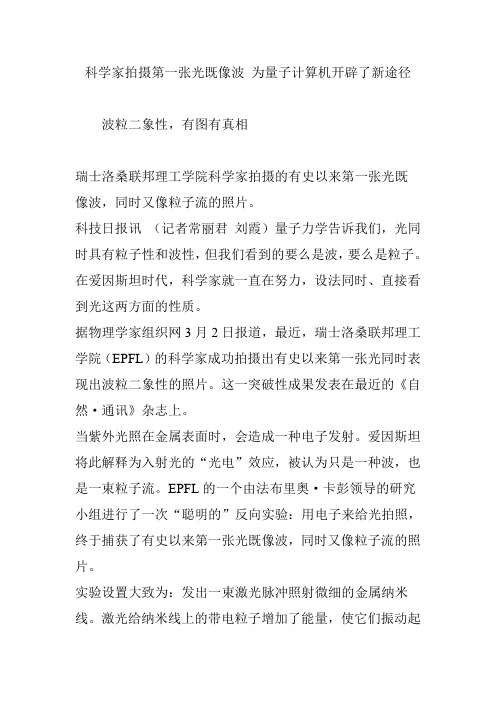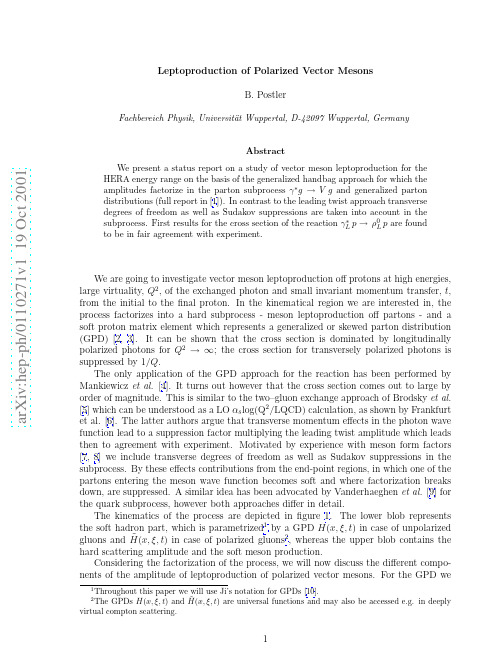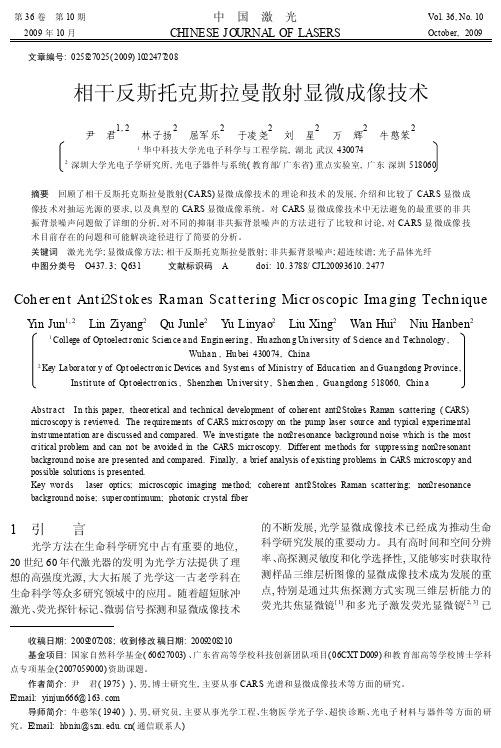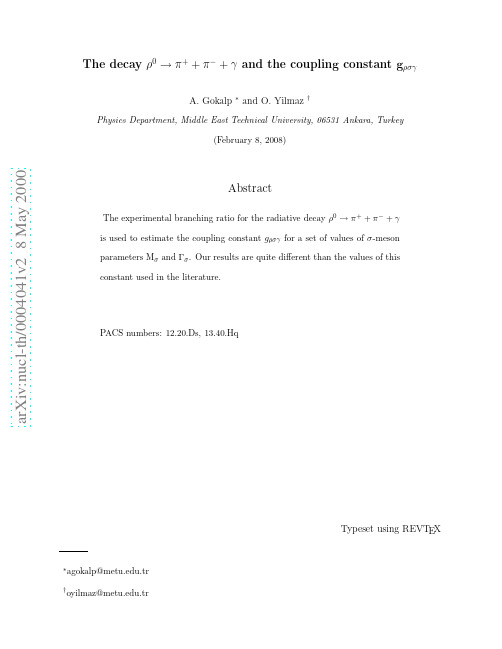Photoproduction of Pseudoscalar Mesons
- 格式:pdf
- 大小:177.43 KB
- 文档页数:4

物理表面等离子体亚波长光学前沿进展3张斗国 王 沛 焦小瑾 唐 麟 鲁拥华 明 海(中国科学技术大学物理系 合肥 230026)摘 要 目前表面等离子体激元(surface p las mon polarit ons,SPPs )在光存储、光激发、显微术以及生物光子学等领域中的应用前景受到了广泛的关注.文章介绍了SPPs 的基本性质和表面等离子体亚波长光学(surface p las monssub wavelength op tics )研究中的热点问题及发展方向.关键词 亚波长光学,表面等离子体激元,纳米光子器件Progress i n surface pl a s m on subwavelength opti csZHANG Dou 2Guo WANG Pei J I A O Xiao 2Jin T ANG L in LU Yong 2Hua M I N G Hai(D epart m ent of Physics,U niversity of Science and Technology of China,Hefei 230026,China )Abstract Now great attenti on is being paid t o the potential app licati ons of surface p las mon polarit ons (SPPs )in data storage,light generati on,m icroscopy and bi o 2photonics .W e review the p roperties of SPPs and top ics of recent interest in surface p las mon subwavelength op tics .Keywords subwavelength op tics,surface p las mon,nanoscale op tical devices3 国家自然科学基金(批准号:90206002,10474093)、中国高技术研究发展计划(批准号:2002AA313030)、安徽省自然科学基金(批准号:03046204)资助项目2004-11-18收到初稿,2005-03-07修回 通讯联系人.Email:m inghai@ustc .edu .cn1 引言表面等离子激元(surface p las mon polarit ons,SPPs )就是局域在金属表面的一种由自由电子和光子相互作用形成的混合激发态[1].在这种相互作用中,自由电子在与其共振频率相同的光波照射下发生集体振荡.这种表面电荷振荡与光波电磁场之间的相互作用就构成了具有独特性质的SPPs .通过改变金属表面的(亚波长)结构,表面等离子激元的性质,特别是与光的相互作用,也随着变化.表面等离子激元为发展新型光子器件、宽带通讯系统、尺度远小于现在能够达到水平的微小光子回路、新型光学传感器和测量技术提供了可能[2,3].目前,表面等离子亚波长光学成为光学和光子学中迅速发展的研究方向之一.本文中我们介绍SPPs 的基本性质、激发方式,特别介绍它在亚波长光学中的热点问题以及SPPs 研究的发展方向[4].2 表面等离子激元的基本性质及其激发方式图1所示的是在金属薄膜界面上沿x 方向传播的SPPs,其电场方程表示为[1]E sp (x,z )=E 0e i k s p x -k z |z|,(1)上式表明在垂直于金属表面的方向电场强度是呈指数衰减的,对应于SPPs 的表面局域特性.SPPs 另一个独特的性质是近场增强,场增强的程度取决于金属的介电系数、表面粗糙程度引起辐射损耗以及金属薄膜的厚度.在理想平滑表面最大可能的增强可表述为[1]E z =0s pE lihgt2=2εiRe εm2I m εma1+Re εm,(2)・805・ 34卷(2005年)7期其中a 2=|Re εm (εs -1)-εs ,E light 是入射光的强度,εs 是金属薄膜下面的介质的介电常数.比如,当用红光照射60n m 厚的银膜激发SPPs 时,电场强度可以提高两个数量级以上[1].在平滑表面传播的SPPs 的色散关系表达式是:k 2sp =ωc 2εi εm εi +εm,,i =1,2.(3)图1 在金属介质界面上传播的SPPs [1] 图2所示的就是SPPs 和光子的色散曲线,由图可以看出SPPs 的波矢大于光子波矢,所以在光滑平面上无法直接和光耦合,这也说明SPPs 的短波长特性.图2 SPPs 的色散曲线和光波的色散曲线[1]要使光子和SPPs 的波矢相匹配可以利用全内反射中的光子隧道效应(Kretsch mann 结构或者O tt o结构)或者利用衍射效应(如图3所示[5]).图3(a )所示的是Kretsch mann 结构,入射光以大于全内反射角的角度入射到棱镜金属的界面,当满足k sp =ωcεp ris m sinθ时,即可有效地激发SPPs .图3(b )是双层Kretsch mann 结构,在两个界面均可激发SPPs .图3(c )所示是对应于金属薄膜很厚的情况下激发SPPs 所采用的O tt o 结构,这种结构的共振条件和Kretsch mann 结构一样.图3(e )所示是利用近场衍射效应激发SPPs .匹配条件是:图3 激发SPPs 的结构图[5] (a )Kretschmann 结构;(b )双层Kretschmann 结构;(c )O tt o 结构;(d )利用NS OM 探针激发;(e )光栅衍射激发;(f )粗糙表面的激发 k s p =ωcn s (sin θ)u xy δp ±p 2πDu x ±q2πDu y ,(4)式中u xy 是入射光方向的单位矢量,u x ,u y 分别是周期性结构的单位矢量,θ是入射角.对于P 偏振光δp =1,对于S 偏振的δp =0,n s 是与金属接触的介质的介电常数.D 是周期(我们默认x 方向和y 方向的周期是一样的).p,q 是整数,对应于不同的衍射级次.对于粗糙的表面,可以不需要其他特别的结构就可以激发SPPs,如图3(f )所示.这是因为在近场区域内的衍射场包含了所有的波矢.这是一种非共振激发SPPs 的方法,激发效率低.近场扫描光学显微镜(NS OM )的探针可以在给定表面上的任意一点激发SPPs,如图3(d )所示,这种激发方式既可以理解为是由于隧道效应产生的也可以认为是衍射效应引起的.3 当前表面等离子体亚波长光学研究的热点问题3.1 SPPs 光场的探测方法研究目前SPPs 的性质和金属表面结构之间的关系不是很清楚,而与SPPs 相关的器件就是利用SPPs 在金属表面的传播行为和光场分布特性制成的,因此更详细地了解SPPs 的传播行为是非常有必要的.由于SPPs 是局域在金属表面且涉及到亚波长尺度的结构,因此传统的光学检测手段无法探测SPPs 的传播和分布.目前探测SPPs 光场分布最好的手段是・905・物理利用光子扫描隧道显微镜(PST M )或者处于接收模式的近场扫描光学显微镜(NS OM ).如图4所示就是用PST M 探测到的金属颗粒的相互作用的光场分布图和数值模拟的结果[6].如果在金属的表面制作一些特定结构就可以控制SPPs 的传播.比如说合适的金属长条可以用来做SPPs 波导,又比如在周期性调制的光子表面上引入线缺陷就可以用来制作SPPs 波导.图4所示的排成一条线的金属颗粒就可以用来传SPPs [6].图4 (a )PST M 探测的金属颗粒之间相互作用形成的光场分布;(b )F DT D 数值模拟的结果[9]3.2 SPPs 带隙结构的研究最近15年来光子晶体的研究成为光子学的一个热点问题.这些有关光子晶体的器件主要是由一些半导体或者绝缘材料制成的.利用这些材料制成的波长量级的结构可以用来控制光与物质的相互作用.金属材料也可以是用来制作光子带隙结构,如图5(a )所示[7],金属表面上波长量级的周期性结构可以用来改变在其上传播的SPPs 的性质.当这种结构的周期小于SPPs 模的有效波长的一半时,SPPs 的散射将会产生SPPs 行波和SPPs 禁带,色散曲线将会不连续,如图5(b )所示.对于频率处在色散曲线的带隙范围内的,SPPs 模式密度等于零,也就是说在这个频率不能产生SPPs,而在带隙边缘,SPPs 模式的色散曲线是平滑的,也就是说SPPs 模式密度很高,对应着在金属表面电场强度得到了增强.纳米量级的金属颗粒阵列的局域表面等离子激元也可能产生这种光子带隙现象[8].金属颗粒的SPPs 带隙模式的频率和宽度与它的形状、大小、材料、周围介质有关,因此可以用来发展新型传感器[9].3.3 金属微孔结构和狭缝阵列结构的研究1998年,Ebbesen 在Nature 上发表了亚波长金属小孔阵列结构的异常透过现象的文章[10],实验结果表明:该结构的透过光强不仅远高于经典衍射理论计算结果,而且大于按照小孔所占金属表面的面积比的计算结果,这就意味着照在小孔之间的光也图5 (a )金属带隙材料结构;(b )色散曲线[6]能通过某种方式耦合到金属膜的另一边.对于这种增强的一般的解释是:当光照射在这些亚波长小孔的表面发生衍射和散射,将会在其上产生倏逝场,这些倏逝场一部分由于隧道效应穿透到小孔的另一面,在另外一面倏逝场将会被散射,这样将会形成传播场,在这里SPPs 的近场增强特性对倏逝场的衰减进行了补偿,有效地提高了能量的传输效率.在金属薄膜足够薄的时候,金属上下表面的SPPs 将会发生重叠并通过小孔发生相互作用.但是现在关于这种透过增强的机理还不是十分清楚,SPPs 在其中的作用还有不同的解释.2002年,Ebbesen 又在Science 上发表了利用准周期金属微结构控制出射光束质量的实验文章[11].这种结构如图6所示:图6(a )所示的是小孔,在小孔的周围刻有周期性的同心圆沟槽结构,该周期性结构与特定波长的入射光相互作用激发SPPs,由此产生透过增强效应.在出射端刻有同样的周期性结构,透过小孔的光有很好的方向性.图6(b )所示的结构是在金属膜中间刻一长条,在入射面和出射面长条两边都刻有光栅,这种准周期性金属微结构可以很好地控制出射光的能量和方向性.图6(c )所示是数值模拟的两边有周期性沟槽的单个长条出射光场分布,沟槽的周期是500nm ,沟槽深100nm ,宽40nm ,从图中我们可以看到从长条出射的光束方向・015・ 34卷(2005年)7期图6 (a )单个小孔结构;(b )单个长条;(c )经过单个长条的光束准直效应[13]性和强度都很好,因此可以作为一个新型的光源,在高密度磁光存储以及近场探测中都有很好的应用.最近,我们研究小组利用时域有限差分法对金属狭缝阵列结构的透过机理进行了系统深入的分析.首次发现了表面等离子体谐振模式中存在的类Fabry 2Per ot 效应,揭示了表面等离子体谐振模式和波导谐振模式两种透过增强机制在物理本质上的一致性,全面描述了SPPs 对该结构近、远场光学特性和能量耦合传输过程的影响[12].3.4 SPPs 在纳米光刻中的应用由于光学衍射极限的存在,传统的光学刻写方法无法刻出超衍射极限的精细结构.采用近场光学的方法则可以突破衍射极限,刻出超精细结构.2004年,Luo 提出了表面等离子体谐干涉纳米光刻技术(surface pas mon res onance interference nolithography technique ,SPR I N T ),该技术利用具有短波特性的SPPs 的干涉效应产生超精细光场进行刻写.图7(a )所示的就是SPR I N T 的结构示意图[13],入射光的波长是436nm ,在石英衬底上有一层周期是300n m 金属光栅,当入射光的波长满足一定的条件时,将会在金属光栅上激发SPPs,SPPs 相互干涉形成周期比金属光栅小的另一套光场光栅.图7(b )所示的就是用时域有限差分法模拟SPPs 干涉的结果,干涉效应形成的光场光栅周期为100nm ,小于波长的一半(218nm ).图7(c )是利用该结构所做的实验结果,由图可见刻出光栅的周期为100nm ,说明该结构可以突破衍射极限.图7 (a )利用SPPs 干涉光刻结构图;(b )数值模拟的结果;(c )实验的结果[14]我们研究小组对这种结构进行了系统深入的数值模拟分析,发现该技术对光栅和光刻胶之间的间隙有苛刻的要求,增加了实用难度.2004年又有学者提出利用金属银膜的完美透镜效应进行光刻的技术[14].图8(a )所示的是利用银膜在特性波长下的完美透镜特性制成的光刻结构,图8(b )所示的是利用时域有限差分法模拟这种银膜对倏逝场的聚焦特・115・物理性.这种结构对光栅和光刻胶之间的间隙要求不是很苛刻.基于此,我们提出了一种新型近场超分辨光刻技术———SPPs 干涉完美成像技术的设计方案,数值模拟的结果表明该结构不仅能保持很高的空间分辨率也具有更好的空间容忍度[15].图8 (a )利用银膜超透镜效应的光刻结构;(b )数值模拟的结果[15]4 表面等离子体亚波长光学的其他发展方向SPPs 除了在小尺度光子回路上有很好的应用外,在其他的光子技术方面也有很好的应用前景.最显著的就是在光的产生方面,比如在有机发光二极管、量子阱激光器光子等器件中的应用[16—18],这些都是表面等离子体亚波长光学的发展方向.另外,由于SPPs 将光的能量聚集在亚波长结构中会引起电场强度的增强,从而会产生非线性现象,因此可以利用这个效应发展近场非线性光学[19,20].如利用非线性现象制作纳米量级的光学开关,又如,用于探测新分子的近场拉曼光谱仪经常利用表面等离子体共振增强效应来增强光信号[21].同时负折射率介质是当前国际研究的热点问题,研究发现:这种特殊物质的一些奇特性质可以利用金属材料来实现,并且和SPPs 密切相关,这也为SPPs 研究和应用开辟了一条新道路[22].参考文献[1]Raether H.Surface Plas mons .Ed .Hohler G .Sp ringer,Ber 2lin,1988[2]Hecht B ,B ielefeldt H,Novotny L et al .Phys .Rev .Lett .,1996,77:1889[3]Pendry J.Science,1999,285:1687[4]BarnesW L,Dereux A,Ebbesen T W.Nature,2003,424:824[5]Zayats A V,S molyaninov I I .J.Op t .A.2003,5:S16[6]Krenn J R et al .Phy .Re w .Lett .,1999,82:2590[7]Kits on S C,Barnes W L,Sa mbles J R.Phys .Rev .Lett .,1996,77:2670[8]Ed .Schiller D.Special issue:Op tical Pr operties of Nanoparti 2cles .App l .Phys . B.2001,73[9]Schultz D A.Curr .Op in .B i otechnol .2003,14:13[10]Ebbesen T W ,Lezec H J,Ghae m i H F et al .Nature,1998,391:667[11]Lezec H J et al .Science,2002,107:1895[12]J iao X,W ang P,M ing H et al .App l .Phys .B,2005,in p ress [13]Luo X G et al .App l .Phys .Lett .,2004,84:4780[14]David O S et al .App l .Phys .Lett .,2004,84:4403[15]J iao X J,W ang P,M ing H et al .2005,subm itted[16]Andre w P,Kits on S C,BarnesW L.J.Mod .Op t .1997,44:395[17]W est phalen M ,Kreibig U,Rostalski J et al .Sol .EnergyMat .Sol .Cells,2000,61:97[18]Tredicucci A et al .App l .Phys .Lett .,2000,76:2164[19]Coutaz J L,Neviere M,Pic E et al .Rev .B,1985,32:2227[20]Tsang T Y .F .Op t .Lett .,1996,21,245[21]Knei pp K et al .Phys .Rev .Lett .,1997,78:1667[22]Kik P G,Maier S A ,A t w ater H A.Phys .Rev .B ,2004,69:45418・215・。


科学家拍摄第一张光既像波为量子计算机开辟了新途径波粒二象性,有图有真相瑞士洛桑联邦理工学院科学家拍摄的有史以来第一张光既像波,同时又像粒子流的照片。
科技日报讯(记者常丽君刘霞)量子力学告诉我们,光同时具有粒子性和波性,但我们看到的要么是波,要么是粒子。
在爱因斯坦时代,科学家就一直在努力,设法同时、直接看到光这两方面的性质。
据物理学家组织网3月2日报道,最近,瑞士洛桑联邦理工学院(EPFL)的科学家成功拍摄出有史以来第一张光同时表现出波粒二象性的照片。
这一突破性成果发表在最近的《自然·通讯》杂志上。
当紫外光照在金属表面时,会造成一种电子发射。
爱因斯坦将此解释为入射光的“光电”效应,被认为只是一种波,也是一束粒子流。
EPFL的一个由法布里奥·卡彭领导的研究小组进行了一次“聪明的”反向实验:用电子来给光拍照,终于捕获了有史以来第一张光既像波,同时又像粒子流的照片。
实验设置大致为:发出一束激光脉冲照射微细的金属纳米线。
激光给纳米线上的带电粒子增加了能量,使它们振动起来。
光沿着这条微细纳米线以两个可能的方向传播,就像高速路上的车辆。
当波以相反的方向传播,互相碰在一起时,就会形成一种新的波,看起来像停驻在那里。
在此,这种驻波成为实验中的光源,向纳米线的周围辐射。
实验中所用的技巧在于,研究人员发射了一束电子接近纳米线,用这束电子来给停驻的光波拍照,当电子和驻波在纳米线上相互作用时,它们要么加快,要么减慢。
用超快显微镜拍摄这一速度改变的位置,就能使驻波变得可见,就像光的波性指纹。
而这种现象不仅能显示出光的波状特性,同时也显示了粒子特性。
当电子接近光驻波时,它们会“撞击”光粒子,也就是光子,这会影响它们的速度,让它们的速度更快或更慢。
这种速度的变化显示了电子和光子之间的能量“包”(量子)的交换,正是这些能量包的出现,显示了纳米线上的光的粒子性。
“这项实验第一次证明了我们能直接拍摄量子力学现象及其矛盾的性质。


第36卷 第10期中 国 激 光Vol.36,No.102009年10月CHINESE JO URNA L OF LASERSOctober,2009文章编号:025827025(2009)1022477208相干反斯托克斯拉曼散射显微成像技术尹 君1,2林子扬2 屈军乐2 于凌尧2 刘 星2 万 辉2 牛憨笨21华中科技大学光电子科学与工程学院,湖北武汉4300742深圳大学光电子学研究所,光电子器件与系统(教育部/广东省)重点实验室,广东深圳518060摘要 回顾了相干反斯托克斯拉曼散射(CARS)显微成像技术的理论和技术的发展,介绍和比较了CAR S 显微成像技术对抽运光源的要求,以及典型的CARS 显微成像系统。
对CARS 显微成像技术中无法避免的最重要的非共振背景噪声问题做了详细的分析,对不同的抑制非共振背景噪声的方法进行了比较和讨论,对CARS 显微成像技术目前存在的问题和可能解决途径进行了简要的分析。
关键词 激光光学;显微成像方法;相干反斯托克斯拉曼散射;非共振背景噪声;超连续谱;光子晶体光纤中图分类号 O437.3;Q631 文献标识码 A doi :10.3788/CJL 20093610.2477Coh er en t Ant i 2St ok es Ra man Scat tering Micr oscopic Ima ging Techn iqueY in Jun 1,2 Lin Ziyang 2 Qu Junle 2 Y u Linyao 2 Liu Xing 2 Wan Hui 2 Niu Hanben 21College of Optoelect r onic Scien ce a nd Engin eer ing ,Hu azhon g Un iver sity of S cience an d Technology ,Wuha n ,Hu bei 430074,China2Key La bor a tor y of O pt oelectr on ic Devices a nd Syst em s of Ministr y of Educa tion an d Gua ngdong Pr ovince ,Instit ute of O pt oelectr on ics ,Shenzhen Un iver sit y ,S hen zhen ,Gua ngdong 518060,Chin aAbstr a ct I n this pape r,theor etical and technical development of coher ent anti 2Stoke s Raman scatte ring (CA RS)microscopy is r eviewe d.The re quire me nts of CA RS micr oscopy on the pump laser sour ce and typical e xpe rime ntal instr ume ntation ar e discussed and compared.We inve stigate the non 2r esonance background noise which is the most cr itical problem and can not be avoide d in the CA RS micr oscopy.Differ ent me thods for suppre ssing non 2re sonant background noise are pre sented and compared.Finally,a brief analysis of e xisting problems in CA RS microscopy and possible solutions is presented.Key wor ds laser optics;microscopic imaging me thod;cohere nt anti 2Stokes Raman scatter ing;non 2r esonance background noise;super continuum;photonic cr ystal fiber收稿日期:2009207208;收到修改稿日期:2009208210基金项目:国家自然科学基金(60627003)、广东省高等学校科技创新团队项目(06CXT D009)和教育部高等学校博士学科点专项基金(2007059000)资助课题。

a rXiv:n ucl-t h /441v28Ma y2The decay ρ0→π++π−+γand the coupling constant g ρσγA.Gokalp ∗and O.Yilmaz †Physics Department,Middle East Technical University,06531Ankara,Turkey(February 8,2008)Abstract The experimental branching ratio for the radiative decay ρ0→π++π−+γis used to estimate the coupling constant g ρσγfor a set of values of σ-meson parameters M σand Γσ.Our results are quite different than the values of this constant used in the literature.PACS numbers:12.20.Ds,13.40.HqTypeset using REVT E XThe radiative decay processρ0→π++π−+γhas been studied employing different approaches[1,5].There are two mechanisms that can contribute to this radiative decay: thefirst one is the internal bremsstrahlung where one of the charged pions from the decay ρ0→π++π−emits a photon,and the second one is the structural radiation which is caused by the internal transformation of theρ-meson quark structure.Since the bremsstrahlung is well described by quantum electrodynamics,different methods have been used to estimate the contribution of the structural radiation.Singer[1]calculated the amplitude for this decay by considering only the bremsstrahlung mechanism since the decayρ0→π++π−is the main decay mode ofρ0-meson.He also used the universality of the coupling of theρ-meson to pions and nucleons to determine the coupling constant gρππfrom the knowledge of the coupling constant gρter,Renard [3]studied this decay among other vector meson decays into2π+γfinal states in a gauge invariant way with current algebra,hard-pion and Ward-identities techniques.He,moreover, established the correspondence between these current algebra results and the structure of the amplitude calculated in the single particle approximation for the intermediate states.In corresponding Feynman diagrams the structural radiation proceeds through the intermediate states asρ0→S+γwhere the meson S subsequently decays into aπ+π−pair.He concluded that the leading term is the pion bremsstrahlung and that the largest contribution to the structural radiation amplitude results from the scalarσ-meson intermediate state.He used the rough estimate gρσγ≃1for the coupling constant gρσγwhich was obtained with the spin independence assumption in the quark model.The coupling constant gρππwas determined using the then available experimental decay rate ofρ-meson and also current algebra results as3.2≤gρππ≤4.9.On the other hand,the coupling constant gσππwas deduced from the assumed decay rateΓ≃100MeV for theσ-meson as gσππ=3.4with Mσ=400MeV. Furthermore,he observed that theσ-contribution modifies the shape of the photon spectrum for high momenta differently depending on the mass of theσ-meson.We like to note, however,that the nature of theσ-meson as a¯q q state in the naive quark model and therefore the estimation of the coupling constant gρσγin the quark model have been a subject ofcontroversy.Indeed,Jaffe[6,7]lately argued within the framework of lattice QCD calculation of pseudoscalar meson scattering amplitudes that the light scalar mesons are¯q2q2states rather than¯q q states.Recently,on the other hand,the coupling constant gρσγhas become an important input for the studies ofρ0-meson photoproduction on nucleons.The presently available data[8] on the photoproduction ofρ0-meson on proton targets near threshold can be described at low momentum transfers by a simple one-meson exchange model[9].Friman and Soyeur [9]showed that in this picture theρ0-meson photoproduction cross section on protons is given mainly byσ-exchange.They calculated theγσρ-vertex assuming Vector Dominance of the electromagnetic current,and their result when derived using an effective Lagrangian for theγσρ-vertex gives the value gρσγ≃2.71for this coupling ter,Titov et al.[10]in their study of the structure of theφ-meson photoproduction amplitude based on one-meson exchange and Pomeron-exchange mechanisms used the coupling constant gφσγwhich they calculated from the above value of gρσγinvoking unitary symmetry arguments as gφσγ≃0.047.They concluded that the data at low energies near threshold can accommodate either the second Pomeron or the scalar mesons exchange,and the differences between these competing mechanisms have profound effects on the cross sections and the polarization observables.It,therefore,appears of much interest to study the coupling constant gρσγthat plays an important role in scalar meson exchange mechanism from a different perspective other than Vector Meson Dominance as well.For this purpose we calculate the branching ratio for the radiative decayρ0→π++π−+γ,and using the experimental value0.0099±0.0016for this branching ratio[11],we estimate the coupling constant gρσγ.Our calculation is based on the Feynman diagrams shown in Fig.1.Thefirst two terms in thisfigure are not gauge invariant and they are supplemented by the direct term shown in Fig.1(c)to establish gauge invariance.Guided by Renard’s[3]current algebra results,we assume that the structural radiation amplitude is dominated byσ-meson intermediate state which is depicted in Fig. 1(d).We describe theρσγ-vertex by the effective LagrangianL int.ρσγ=e4πMρMρ)2 3/2.(3)The experimental value of the widthΓ=151MeV[11]then yields the value g2ρππ2gσππMσ π· πσ.(4) The decay width of theσ-meson that follows from this effective Lagrangian is given asΓσ≡Γ(σ→ππ)=g2σππ8 1−(2Mπ2iΓσ,whereΓσisgiven by Eq.(5).Since the experimental candidate forσ-meson f0(400-1200)has a width (600-1000)MeV[11],we obtain a set of values for the coupling constant gρσγby considering the ranges Mσ=400-1200MeV,Γσ=600-1000MeV for the parameters of theσ-meson.In terms of the invariant amplitude M(Eγ,E1),the differential decay probability for an unpolarizedρ0-meson at rest is given bydΓ(2π)31Γ= Eγ,max.Eγ,min.dEγ E1,max.E1,min.dE1dΓ[−2E2γMρ+3EγM2ρ−M3ρ2(2EγMρ−M2ρ)±Eγfunction ofβin Fig.5.This ratio is defined byΓβRβ=,Γtot.= Eγ,max.50dEγdΓdEγ≃constant.(10)ΓσM3σFurthermore,the values of the coupling constant gρσγresulting from our estimation are in general quite different than the values of this constant usually adopted for the one-meson exchange mechanism calculations existing in the literature.For example,Titov et al.[10] uses the value gρσγ=2.71which they obtain from Friman and Soyeur’s[9]analysis ofρ-meson photoproduction using Vector Meson Dominance.It is interesting to note that in their study of pion dynamics in Quantum Hadrodynamics II,which is a renormalizable model constructed using local gauge invariance based on SU(2)group,that has the sameLagrangian densities for the vertices we use,Serot and Walecka[14]come to the conclusion that in order to be consistent with the experimental result that s-waveπN-scattering length is anomalously small,in their tree-level calculation they have to choose gσππ=12.Since they use Mσ=520MeV this impliesΓσ≃1700MeV.If we use these values in our analysis,we then obtain gρσγ=11.91.Soyeur[12],on the other hand,uses quite arbitrarly the values Mσ=500 MeV,Γσ=250MeV,which in our calculation results in the coupling constant gρσγ=6.08.We like to note,however,that these values forσ-meson parameters are not consistent with the experimental data onσ-meson[11].Our analysis and estimation of the coupling constant gρσγusing the experimental value of the branching ratio of the radiative decayρ0→π++π−+γgive quite different values for this coupling constant than used in the literature.Furthermore,since we obtain this coupling constant as a function ofσ-meson parameters,it will be of interest to study the dependence of the observables of the reactions,such as for example the photoproduction of vector mesons on nucleonsγ+N→N+V where V is the neutral vector meson, analyzed using one-meson exchange mechanism on these parameters.AcknowledgmentsWe thank Prof.Dr.M.P.Rekalo for suggesting this problem to us and for his guidance during the course of our work.We also wish to thank Prof.Dr.T.M.Aliev for helpful discussions.REFERENCES[1]P.Singer,Phys.Rev.130(1963)2441;161(1967)1694.[2]V.N.Baier and V.A.Khoze,Sov.Phys.JETP21(1965)1145.[3]S.M.Renard,Nuovo Cim.62A(1969)475.[4]K.Huber and H.Neufeld,Phys.Lett.B357(1995)221.[5]E.Marko,S.Hirenzaki,E.Oset and H.Toki,Phys.Lett.B470(1999)20.[6]R.L.Jaffe,hep-ph/0001123.[7]M.Alford and R.L.Jaffe,hep-lat/0001023.[8]Aachen-Berlin-Bonn-Hamburg-Heidelberg-Munchen Collaboration,Phys.Rev.175(1968)1669.[9]B.Friman and M.Soyeur,Nucl.Phys.A600(1996)477.[10]A.I.Titov,T.-S.H.Lee,H.Toki and O.Streltrova,Phys.Rev.C60(1999)035205.[11]Review of Particle Physics,Eur.Phys.J.C3(1998)1.[12]M.Soyeur,nucl-th/0003047.[13]S.I.Dolinsky,et al,Phys.Rep.202(1991)99.[14]B.D.Serot and J.D.Walecka,in Advances in Nuclear Physics,edited by J.W.Negeleand E.Vogt,Vol.16(1986).TABLESTABLE I.The calculated coupling constant gρσγfor differentσ-meson parametersΓσ(MeV)gρσγ500 6.97-6.00±1.58 8008.45±1.77600 6.16-6.68±1.85 80010.49±2.07800 5.18-9.11±2.64 90015.29±2.84900 4.85-10.65±3.14 90017.78±3.23Figure Captions:Figure1:Diagrams for the decayρ0→π++π−+γFigure2:The photon spectra for the decay width ofρ0→π++π−+γ.The contributions of different terms are indicated.Figure3:The pion energy spectra for the decay width ofρ0→π++π−+γ.The contri-butions of different terms are indicated.Figure4:The decay width ofρ0→π++π−+γas a function of minimum detected photon energy.Figure5:The ratio Rβ=Γβ。
西班牙科学家展示了一种细胞外囊泡的新型全息荧光成像方法全息摄影技术以记录物体散射光的干涉图样并产生3D图像(全息图)的能力而闻名。
这个简单的光学实验记录下电场的振幅以及通常不可见的相位,可用于在所有3D层面同时定位许多单个粒子。
全息摄影技术在生物学上不那么普遍。
生物学上将灵敏度、分辨率和特异性结合在一起的最合适的技术是荧光成像,它广泛用于活细胞成像。
如果能将荧光显微镜与全息摄影技术结合起来,从而检索出细胞内荧光标记实体的完整3D分布,那将是非常奇妙的。
不幸的是,荧光通常是不相干的,光程长度和相位记忆很短,荧光干扰会使得产生全息图的参考波变得复杂。
近日,西班牙巴塞罗那佛罗伦萨科学技术研究所(ICFO)的研究人员Matz Liebel和Jaime Ortega-Arroyo 展示了一种全息荧光成像方法,他们是ICFO Niek van Hulst和Romain Quidant的ICREA教授小组的成员。
在这项研究中,研究人员实施了消除参考波的方案。
取而代之的是,他们使用每个横向光子的本征相位信息,通过一种称为横向剪切干涉法的技术来访问其相位。
从本质上讲,研究人员不是直接测量相位,而是使用CMOS相机测量了宽视场中与位置有关的相位变化。
接下来,研究人员在计算上整合了此信息,以单分子敏感性恢复了荧光的整个电场。
该新颖方案通过消除对相位循环的需求,将数字全息摄影技术的原理扩展到了快速荧光检测,并能够以15 nm的面内分辨率和8微米的z范围对单个纳米粒子进行3D跟踪。
然后,Liebel和Ortega-Arroyo与位于波士顿麻省总医院的Hakho Lee团队合作,对活细胞内的细胞外囊泡(EVs)的3D运动进行成像和跟踪。
研究人员解决了近乎各向同性的3D扩散以及定向传输问题。
有趣的是,对于扩展的观察窗,他们观察到了向各向异性运动的过渡,其中EV在轴向上沿水平方向的长距离传输。
荧光全息摄影技术与目前的超分辨率技术直接兼容,并且同样非常适合其他体积样本的成像,例如组织中的跟踪或钙成像。
a r X i v :n u c l -e x /0211029v 1 25 N o v 20021Photoproduction of Pseudoscalar Mesons R.A.Arndt a ,W.J.Briscoe a ,G.V.O’Rielly b ,I.I.Strakovsky a ,R.L.Workman a a The Center for Nuclear Studies,Department of Physics,The George Washington University,Washington,D.C.20052b Department of Physics,University of Massachusetts Dartmouth,M.A.02747Experiments that study the photoproduction of pseudoscalar mesons;pions,etas and kaons,have the potential to increase our knowledge of baryon and hyperon resonance properties.Recent experiments at JLab,Mainz,GRAAL,and Bonn are beginning to produce results in the form of polarization and asymmetry measurements and determi-nations of the differential and integrated cross sections.These new data are essential to the performance of Partial-Wave Analyses that are less model dependent and coupled-channels calculations that incorporate unitarity dynamically,combining hadronic reaction channels together with electromagnetic processes.This approach is necessary to extract resonance properties and may lead to the identification of missing,but predicted,res-onances.Some recent experimental and phenomenological results for single and double pseudoscalar meson photoproduction are discussed.Studies of the baryon spectrum have generally been data-base driven.While most states were first detected through hadronic scattering (mainly pion-nucleon),present researchis focused on resonance excitation by real and virtual photon probes.The photo-and electroproduction of pseudoscalar mesons has been studied most intensively for a number of practical reason.First,in the case of pion production,there is a clear and direct con-nection to the extensive results from elastic pion-nucleon scattering.Here one benefits from knowing,in advance,the resonances which couple most strongly to the final state.Second,in general,pseudoscalar-meson production is relatively easy to analyze.Many additional amplitudes contribute to the production of vector mesons,for example.How-ever,if one is looking for “missing resonances,”states not found in the elastic scattering or electromagnetic production of single pseudoscalar mesons,the search must be extended to processes having other final states (such as two-meson productions).It has become clear over the last decade that any attempt at an unambiguous descrip-tion of resonances requires a comprehensive approach to the analysis of all contributing reactions.In order to be able to perform such coupled-channel analyses,one needs easy access to all related sets of experimental data,in addition to a theoretical and calcula-tional framework for a common description.The availability of partial-wave amplitudes greatly simplifies numerical aspects of coupled-channel analysis.The number of fitted partial-wave amplitudes associated with a dataset may be smaller than the count of indi-vidual data by orders of magnitude,and can account for issues associated with statistical2and systematic errors and the rejection of inconsistent measurements.In Fig.1,we compare the SAID and MAIDfits to existing data and preliminary CLAS data for single-pion photoproduction.Note that the variation infits to existing data would be unacceptable if only CLAS data were retained.Differences,usually minor in the unpolarized cross sections,are magnified in predictions of single and double polarization observables.Figure1.Preliminary differential cross sec-tion data in the p(γ,p)π0reaction at Eγ=1000MeV from the CLAS g1c run group(solid circles)[1].Data are compared to theworld data(open circles),along with SM02[2]solution(solid line)and MAID[3](dashedline)predictions.In Fig.2,we compare SAID and MAID results for the differential and total cross section(polarized beam-target)contributing to the the GDH sum rule.The inclusion of this and other precise polarization data has led a number of groups to propose changes to supposedly well-known resonance states.Note that the single-pion contribution to the sum rule is negligible by2GeV.Figure2.Difference of the(a)differential and(b)total cross sections for the helicity states1/2and3/2for γ p→π0p.The solid(dash-dotted)line represents the SM02[2] (MAID2001[3])solution.Experimental data are from Mainz[4,5].In Fig.3,we show results for double-pion photoproduction,which displays structures3 which have been attributed to states not strongly seen in single-pion production.Here, however,interpretation is more difficult,again motivating a multi-channel treatment.Figure3.Total cross section for theγp→pπ0π0reaction.Preliminary CLAS data[6]are com-pared to the world data(open circles)obtainedwith the DAPHNE’98and TAPS’99detectors.CLAS data are plotted with statistical errors.The band at the top of thefigure delineates therange of systematic uncertainties.In Fig.4,two GWfits to the S-wave dominated eta-photoproduction differential cross sections are displayed.This reaction has the potential to give cleaner information on the N(1535)resonance,the pion channel being masked by a sharp cusp effect(due to the eta-nucleon threshold).Note that bothfits,and also afit from the Mainz group,tends to drop offrapidly at very forward angles.An interesting preliminary set of data from GRAAL suggests aflatter extrapolation to the forward direction,which would necessitate a re-examination of the underlying assumptions in mostfits(a smoother behaviour appears to be predicted by the model of Li and Saghai.)Fits to pion electroproduction and kaon photoproduction have also been completed,and a multi-channel K-matrix approach to eta photoproduction is being explored.Furtherfits and an expansion of our on-line database is expected in the near future. AcknowledgmentsThis work has been supported by U.S.Department of Energy grant DE-FG02-99-ER41110.Additional support has been provided by Jefferson Lab and the Southeastern Universities Research Association through the D.O.E.contract DE-AC05-84ER40150.4d σ/d Ω (µb /s r )cos θc.m.Figure 4.CLAS γp →ηp differential cross sec-tions.CLAS data (solid circles)[7]are com-pared to the GRAAL data (open squares)[8]along with SM01solution with CLAS data included,and BO12solution with CLAS data excluded [9].REFERENCES1.M.Wood,private communication,2002.2.R.A.Arndt,W.J.Briscoe,I.I.Strakovsky,and R.L.Workman,to be published inPhys.Rev.C 66(2002)0552xx;3.Mainz fits are available at the MAID website http://www.kph.uni-mainz.de/MAID/.See also S.S.Kamalov et al.,Phys.Rev.C 64(2001)032201.The Unitary Isobar Model is developed at Mainz (hereafter called MAID),D.Drechsel et al.,Nucl.Phys.A645(1999)145.MAID2000refers to the Feb.2001version of the MAID solution,MAID2001refers to the Nov.2001version of the MAID solution from S.Kamalov.4.J.Ahrens et al.,Phys.Rev.Lett.88(2002)232002.5.J.Ahrens et al.,Phys.Rev.Lett.84(2000)5950.6.S.Philips,Ph.D.Thesis,The George Washington University,Jan.2002.7.M.Dugger et al.,Phys.Rev.Lett.89(2002)222002.8. F.Renard et al.,Phys.Lett.B528,215(2002).9.R.A.Arndt,I.I.Strakovsky,and R.L.Workman,in progress;.。